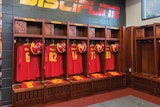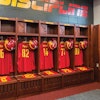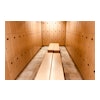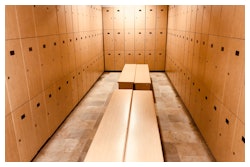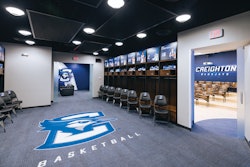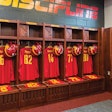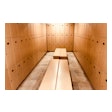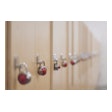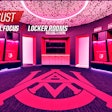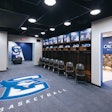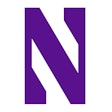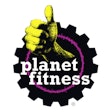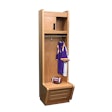![University of Iowa Football Therapy Pools [Images of the University of Iowa Football Operations Facility by Paul Crosby]](https://img.athleticbusiness.com/files/base/abmedia/all/image/2016/04/ab.aquatics416_feat.png?auto=format%2Ccompress&q=70&w=400)
This article appeared in the April issue of Athletic Business. Athletic Business is a free magazine for professionals in the athletic, fitness and recreation industry. Click here to subscribe.
Today's football practice facilities are packed with lavish amenities. Programs at the college and professional levels have been spending millions of dollars to renovate or build new facilities, but it isn't all about impressing recruits. Player health and wellbeing is paramount for these programs, and one feature becoming standard within practice facilities is hot and cold plunge pools.

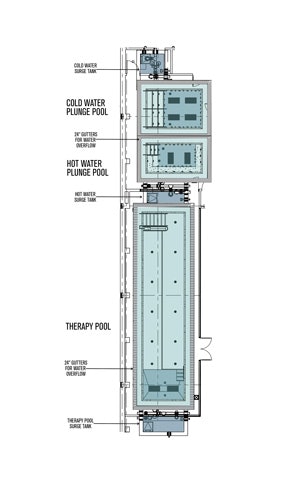 Click to enlarge
Click to enlarge
In 2013, the University of Alabama completed a multimillion-dollar renovation of its existing football operations facility. Along with a state-of-the-art weight room and a players' lounge featuring billiards tables, arcade games and several 70-inch flat-screen televisions, the new Mal M. Moore Athletic Facility boasts two 30-foot aquatic rehabilitation pools containing four waterfalls.
A pair of rehabilitation pools can also be found at the Dallas Cowboys' The Ford Center at The Star in Frisco, Texas. Whether decked out with waterfalls and spa amenities or more basic and utilitarian, aquatic rehabilitation pools are becoming must-have amenities for any competitive football program preparing its players to perform at their best.
Hot and cold plunge pools are vital for rapid muscle recovery and rehabilitation. Hot plunge pools are used pre-workout as a way for players to warm up their muscles before they hit the field or the weight room. Cold plunge pools, or ice baths, are generally used immediately after periods of intense exercise. The cold water restricts the blood flow by causing the blood vessels to contract. Many trainers suggest alternating between hot and cold water to increase blood flow, a process known as contrast water therapy.
OVERFLOWING WITH ATHLETES
The challenges in designing this type of aquatic facility are unique when taking into consideration the patrons who will be using the pools. Imagine five offensive linemen, averaging nearly 300 pounds apiece, all trying to squeeze into a standard hot tub. The result? A flooded pool deck.
Aquatic rehabilitation pool design can compensate for this "surge" by utilizing deep perimeter gutters. The gutters installed on the hot and cold plunge pools at the University of Iowa Football Operations Facility are 24-inches deep (see diagram at left), a size traditionally reserved for high-end competition pools to capture waves and quell turbulent water created by swimmers.
An additional measure taken to prevent overflow is to install a sizable balance tank beneath the pool deck. A balance tank serves as a storage chamber for the water that gets displaced when someone enters the pool. An average person displaces 18 to 20 gallons of water when they enter a pool. A typical football player, however, could easily displace double or even triple that amount.
Another challenge of therapy pool design is water clarity. Football players tend to be at their sweatiest and dirtiest right after a workout, and right before a dip in the cold plunge pool. Keeping the water clean requires a faster turnover rate — the time it takes a pump to recirculate the entire volume of water through the mechanical room and filter system and return clean water back to the pool. For these types of pools, a turnover rate of 15 minutes or less is recommended. This may cause systems to be oversized in comparison to municipal facilities. Fast turnover times and oversized equipment ultimately lead to cleaner water and a more sanitary experience.
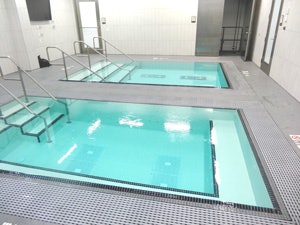 Imagine five offensive linemen, averaging nearly 300 pounds apiece, all trying to squeeze into a standard hot tub. - Click to enlarge
Imagine five offensive linemen, averaging nearly 300 pounds apiece, all trying to squeeze into a standard hot tub. - Click to enlarge
THERAPEUTIC DESIGN
Other design aspects unique to aquatic facilities include temperature, hydrotherapy jets, depth of water and ingress/egress (especially for injured players).
The main difference between a hot plunge pool and a cold plunge pool is, well, the temperature. The pool operator at Alabama regularly makes both pools either hot or cold based on demand. Because the therapeutic function of both relies on temperature, close attention needs to be paid to this factor. Hot plunge pools generally have a temperature range between 100 and 104 degrees Fahrenheit, and cold plunge pools are kept around 55 degrees, and often colder.
Whether hot or cold, all plunge pools utilize hydrotherapy jets. Different nozzle configurations with varying pressures, sizes and quantities allow the user to target individual sore areas. To make the most of these nozzles' therapeutic purpose, it is best to incorporate different depths of water in a pool. The therapy pool at the University of Iowa Football Operations Facility, for instance, has three different water depths; 3 feet, 6 inches; 4 feet, 10 inches; and 6 feet, 4 inches. These varying depths accommodate an array of therapy programs for different applications.
Finally, easy ingress and egress is an important design consideration for therapy pools. Though athletes may appear the picture of health during a game, a hard workout or practice can take its toll and make transitioning in and out of a pool difficult. Depending on the space available, assistive devices such as powered ADA-compliant lifts, transfer walls with grab rails, transfer steps and platforms or accessible pool stairs with handrails can make access easier for athletes.
Connor Riley is a project engineer working out of Counsilman-Hunsaker’s Denver office.
This article originally appeared in the April 2016 issue of Athletic Business with the title "Designing therapy pools for football practice facilities"









